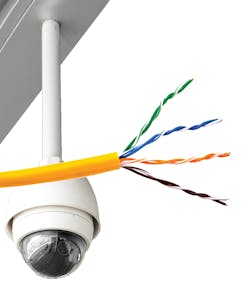There is a new power standard in town, and it goes by several names. Officially it is 802.3bt, but others call it 4PPoE, or, 4 Pair PoE. The Institute of Electrical and Electronics Engineers (IEEE), ratified this new PoE standard in Sept. 2018, and integrators are discovering that this new standard can change the game on how PoE can be used.
As 802.3bt makes its way into our world of security, integrators can take full advantage of its characteristics to save money, labor and make installations much safer to work with. These PoE-driven power supplies and converters, as well as the power sources for this new standard are available today and may be found on the shelf of some of your local distributors.
PoE Before the New Standard
In most cases when using PoE, an integrator would just connect a PoE device such as a camera, illuminator, access control panel, access point, lighting, etc. In some cases, the PoE 802.3af 15.4W Type 1 or PoE+ 802.3at 30W Type 2 simply did not provide enough power. In these scenarios, there were two options for manufacturers to engineer products:
- Option 1 – Use both PoE and a separate low voltage AC or DC power connection, i.e. PoE and 24VAC. This would enable the PoE to power the PTZ camera, while the 24VAC would power the heater/blower or the infrared LEDs.
- Option 2 – Use a non-standard PoE called “Hi-PoE” or “PoE++” that delivered up to 60W of power. Some would think that this is the same as 802.3bt Type 3; however, it is not.
Traditional PoE is delivered by one of two modes. Mode “A” – typically found in a PoE switch – delivers PoE on the same two pairs as data on a category cable. Mode “B” – found in many PoE injectors – delivers PoE on the spare pairs, leaving the data pairs for just data. Hi-PoE uses Mode “A” and Mode “B” simultaneously, which delivers what some specification sheets call Hi-PoE 802.3at (60W) even though it really is not a standard. Using a PTZ camera that works using Hi-PoE as an example, Mode “A” 30W will power the PTZ and motor while Mode “B” 30W powers the heater/blower – totaling 60W.
Going Beyond Hi-PoE
IEEE802.3bt is a different animal and introduces two new types of PoE. Type 3 is up to 55W and Type 4 is up to 90-100W. this means that instead of splitting the PoE into Mode “A” and Mode “B” as is the case with Hi-PoE (60W), the 802.3bt standard uses all four pairs to evenly distribute the power. The amount of power available for Type 3 is 51W and Type 4 allows for up to 75W.
Since it is relatively new, there are very few products on the market that have already adopted 802.3bt. Aside from PoE lighting, as of today there are some infrared illuminators that adhere to 4PPoE.
This new standard enables manufacturers of powered devices to design new products with bigger features, faster motors and more capabilities. With the news that the standard has been ratified, manufacturers will quickly start taking advantage and new products will be available soon.
Currently, there are several sources for PoE injectors that supply 802.3bt up to Type 4. They come in single- or multi-port options with larger wattage power supplies to cut down on the number of injectors for larger projects. We will see many more PoE switches offering 4PPoE outputs in 2020, which is also a good indicator that we will see a lot more devices demanding more power.
How 802.3bt Eliminates High Voltage
There are other ways to use PoE that go beyond plugging directly into a powered device. When we think of power supplies, they normally have a high-voltage input, such as 115VAC that is converted into 24VAC or 12/24VDC. There are other power supplies that accept a 24VAC input and convert to 12VDC or lower.
Just about everything we do in the security industry involves converting voltage. When a simple burglar alarm panel requires 16.5VAC input, the panel then converts this power to 12VDC, which powers the keypad and charges a battery for backup as an example.
Though the video surveillance world is going mostly IP and using PoE for power, HD analog cameras – for the most part – still require 12VDC.
Access control panels vary, but also accept power inputs as high as 30VDC and convert it to a lower useable voltage for powering devices such as card readers. Also in access control, we are seeing high demand for power supplies hardwired with high voltage for electrified locks. These power supplies generally take 115VAC power input and reduce this to a 12VDC or 24VDC output. That single output is then connected to a distribution board, where the electrified magnetic locks or strikes are then connected.
Most jurisdictions require that this power input be hardwired with a dedicated circuit – and because of the high voltage, a certified electrician must be used to properly wire this portion.
While some electrical houses are versed in security and some security integrators do have certified electricians on staff, the use of high voltage still adds to the cost of any installation. In many large cities like Chicago, Boston, New York, Philadelphia, etc., electricians have offices in the very same building the access control system is being installed. This limits an integrator’s ability to contract their own electrician to do the work. Besides contracting the electrician, because of high voltage, the installation now requires dedicated conduit runs for the electrical as well as expensive large gauge copper and a dedicated circuit breaker.
How do we limit this costly practice? The answer lies in the new 802.3bt 4PPoE standard. As previously stated, 4PPoE delivers up to 75W of total power. Why do we have to plug this into a camera or an illuminator that takes PoE? Instead, integrators can just convert this PoE to a lower DC voltage – after all, PoE’s nominal voltage is 48VDC.
In the end, integrators can harness the latest IEEE 802.3bt standard by using it with a PoE-driven power supply. This type of power supply allows for a PoE input of 15.4W, 30W, or the new 4PPoE 100W and converts it to a useable 75W of available power.
Case in Point: A Typical Eight-Door Access Control System
While there are PoE adapters that convert to 12VDC or 24VDC, the available power is limited. With 75W available, the flexibility to power an entire access control system with 4PPoE is a reality. This includes powering the panels, locks, readers, request-to-exits and charging batteries with a single Category 6 cable (see the nearby chart).
Although it is riding on the edge, 75W could power an entire eight-door system. If this is too close for comfort, there are ways the integrator can save power – one way is to use a midspan injector or PoE switch that has battery backup, which would eliminate the battery backup on the PoE-driven power supply and alleviate 10W. If that is not the route you want to take, limit the PoE-driven power supply to 4-6 doors and use two power supplies – putting the 12VDC devices on one power supply and the 24VDC devices on the other. The cost to add the second power supply will certainly be much less than using an electrician. Additionally, the access control manufacturer you are working with may draw less power on the panels. These are all things to take into consideration when laying out a system.
Keep in mind that this method of powering an access control system will eliminate the need to schedule a certified electrician to wire up the power supply, run a dedicated conduit to the electrical panel. The category cable used for power can run in the same cable trays and paths as other network cabling as well as the access control cable. When servicing the system, there would be no high voltage inside the enclosure and unplugging the Ethernet cable from the PoE-driven power supply is safe with no voltage present. Once the cable is plugged back in, the handshake is performed with the power source and 802.3bt PoE is sent back to power the system.
Take a look at a recent access control project you installed and calculate how much you would have saved using 4PPoE and a PoE driven power supply. I think you will be amazed.
Ronnie Pennington is National Sales Engineer for Altronix Corp. Request more info about the company at www.securityinfowatch.com/10212790.
About the Author

Ronnie Pennington
Ronnie Pennington is the national accounts manager for Altronix Corp., based in Brooklyn, N.Y.
